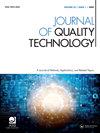Learning Basse R, 2nd edition, Lawrence M. Leemis, 2022, Lightning Source, 368 pp., $40, ISBN: 978-0-9829174-5-9
IF 2.2
2区 工程技术
Q2 ENGINEERING, INDUSTRIAL
引用次数: 0
Abstract
R is one of the most common programming languages used for various statistical modeling and data analysis tasks. Learning Base R (2nd edition) by Lawrence M. Leemis provides an accessible approach to R language for beginners with little to no programming exposure. Unlike other introductory R language books, Learning Base R is more in-depth from a statistical perspective, giving a fundamental overview of R language. In this book, Chapter 1 provides a comprehensive introduction to R language, as well as some tricks to make the R session more efficient. The following two chapters introduce basic arithmetic operations. Then, three elementary data structures, vector, matrices, and arrays, are introduced in Chapters 4 to 6. Chapters 7 and 8 describe built-in and user-written functions, and Chapter 9 introduces some useful utilities. Notably, some new functions have been added to these chapters in this new edition, such as assign, append, and attributes. The next three chapters introduce three other types of elements that can be stored in data structures, complex numbers, character strings, and logical elements. Chapters 13 and 14 introduce the methods for comparing elements with relational operators and coercing elements to specific data types. In addition, a new table summarizing the concept of “is family” of functions is provided in this chapter. Two more advanced data structures, lists and data frames, are introduced in the next two chapters. Chapter 17 shows some built-in data sets in R. Chapter 18 concerns input/output; a more sophisticated application of scan is also introduced here. After introducing these essential topics, some advanced topics are illustrated in the following chapters. Chapter 19 focuses on some suitable functions associated with the probability distributions of random variables. Chapters 20 and 21 give, in very fine detail, how to generate high-level graphics and custom graphics, and Chapters 22 to 24 introduce many of R’s programming capabilities. Chapter 25 explains the topic of the Monto Carlo simulation. Furthermore, Chapters 26 to 28 have the most modification comparing to the previous version. Some brief introductions to statistical inference methods are given in Chapter 26, which includes univariate data analysis, analysis of variance, regression, and time series analysis. Chapter 27 introduces linear algebra functions. Chapter 28 covers some popular packages for data visualization and data analysis, such as ggplot2, lubridate, lpsolve, and other packages in the exercises section. There are over 400 exercises in total, an increase of 265 new exercises (an average of 9–10 new exercises per chapter) from the previous edition, to enhance the reader’s knowledge of R. The book also includes plenty of instructional videos and code for readers to explore, which are available on the author’s website. In conclusion, this book covers the R programming language and all its details in a practical way. For those who are just starting to learn R, this book, along with the relevant examples and exercises, will give you enough knowledge to start using R for various data analysis tasks. There are also some extra tips and tricks to help you write clean and optimized code. If you are keen to learn R from scratch or just want a refresher, I would highly recommend this book.Learning Basse R,第二版,Lawrence M. Leemis, 2022, Lightning Source, 368页,40美元,ISBN: 978-0-9829174-5-9
R是用于各种统计建模和数据分析任务的最常用的编程语言之一。Lawrence M. Leemis的《Learning Base R(第二版)》为几乎没有编程经验的初学者提供了一种易于访问的R语言方法。与其他介绍性R语言书籍不同,《学习基础R》从统计角度更深入,给出了R语言的基本概述。在这本书中,第1章提供了对R语言的全面介绍,以及一些使R会话更有效的技巧。下面两章介绍基本的算术运算。然后,三种基本的数据结构,向量,矩阵和数组,介绍了在第4章至第6章。第7章和第8章描述了内置和用户编写的函数,第9章介绍了一些有用的实用程序。值得注意的是,在这个新版本中,这些章节中添加了一些新函数,例如赋值、追加和属性。接下来的三章将介绍另外三种可以存储在数据结构中的元素:复数、字符串和逻辑元素。第13章和第14章介绍了与关系操作符比较元素和将元素强制为特定数据类型的方法。此外,本章还提供了一个新的表,概述了“is族”函数的概念。两种更高级的数据结构,列表和数据框架,将在接下来的两章中介绍。第17章展示了r语言中的一些内置数据集。第18章关注输入/输出;这里还介绍了扫描的一个更复杂的应用。在介绍了这些基本主题之后,一些高级主题将在以下章节中进行说明。第19章主要讨论与随机变量的概率分布有关的一些合适的函数。第20章和第21章非常详细地介绍了如何生成高级图形和自定义图形,第22章到第24章介绍了R的许多编程功能。第25章解释了蒙特卡罗模拟的主题。此外,第26至28章与前一版本相比修改最多。第26章简要介绍了统计推断方法,包括单变量数据分析、方差分析、回归分析和时间序列分析。第27章介绍线性代数函数。第28章介绍了一些用于数据可视化和数据分析的流行软件包,如ggplot2、lubrication、lpsolve和练习部分中的其他软件包。本书共有400多个习题,比上一版增加了265个新习题(平均每章9-10个新习题),以提高读者对r的认识。本书还包括大量的教学视频和代码,供读者探索,这些都可以在作者的网站上找到。总之,这本书以实用的方式涵盖了R编程语言及其所有细节。对于那些刚刚开始学习R的人来说,这本书以及相关的示例和练习将给你足够的知识,让你开始使用R进行各种数据分析任务。还有一些额外的提示和技巧可以帮助您编写干净和优化的代码。如果你热衷于从头开始学习R,或者只是想复习一下,我强烈推荐这本书。
本文章由计算机程序翻译,如有差异,请以英文原文为准。
求助全文
约1分钟内获得全文
求助全文
来源期刊

Journal of Quality Technology
管理科学-工程:工业
CiteScore
5.20
自引率
4.00%
发文量
23
审稿时长
>12 weeks
期刊介绍:
The objective of Journal of Quality Technology is to contribute to the technical advancement of the field of quality technology by publishing papers that emphasize the practical applicability of new techniques, instructive examples of the operation of existing techniques and results of historical researches. Expository, review, and tutorial papers are also acceptable if they are written in a style suitable for practicing engineers.
Sample our Mathematics & Statistics journals, sign in here to start your FREE access for 14 days
 求助内容:
求助内容: 应助结果提醒方式:
应助结果提醒方式:


